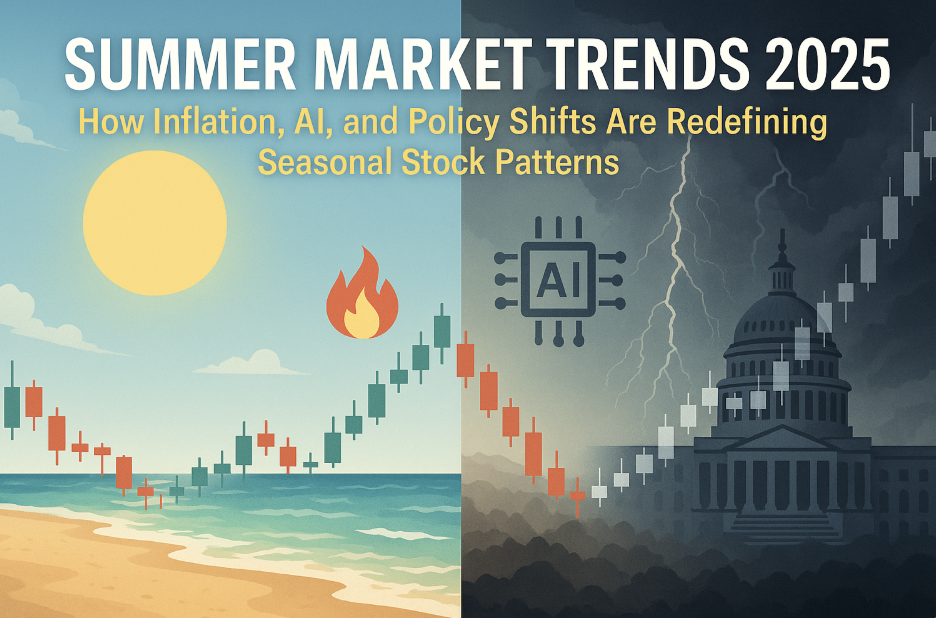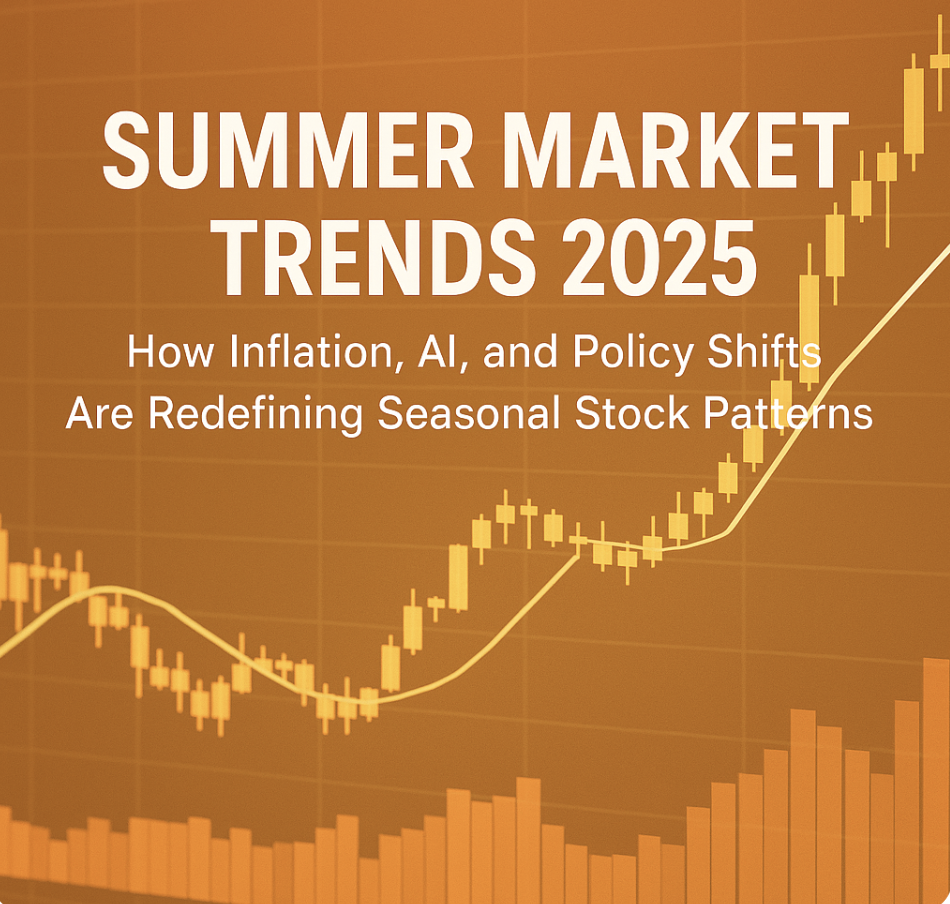Summer Market Trends 2025:How Inflation, AI, and Policy Shifts Are Redefining Seasonal Stock Patterns
Summer Market Trends 2025:How Inflation, AI, and Policy Shifts Are Redefining Seasonal Stock Patterns

The lazy summer trading days that once defined Wall Street have undergone a profound transformation in recent years, challenging the conventional wisdom that has guided investors for generations. While the classic adage “Sell in May and go away” once offered a reliable roadmap for navigating the seasonal doldrums between Memorial Day and Labor Day, today’s markets operate under vastly different dynamics that render this simplistic approach obsolete. This summer presents a complex landscape where three powerful forces—inflationary pressures, accelerating AI integration, and significant policy shifts from the Federal Reserve and the second Trump administration—fundamentally redefine seasonal market patterns.
These modern factors aren’t merely creating short-term anomalies; they’re establishing new structural rhythms that demand sophisticated, adaptive strategies from investors. Throughout this analysis, you’ll gain actionable insights into sector-specific summer opportunities, timing considerations for portfolio repositioning, and volatility management techniques for summer patterns.
Traditional Summer Market Patterns: A Historical Perspective
The notion that markets underperform during summer months isn’t merely anecdotal—it’s supported by decades of historical data that reveal distinct seasonal patterns across major indices. Since 1950, the S&P 500 has delivered an average return of just 1.7% from May through October, compared to 6.8% during the November to April period, while the Dow Jones Industrial Average shows an even starker contrast with 1.4% versus 7.5% returns across the same seasonal divide. Beneath these broad index patterns lies a more nuanced story—utilities, consumer staples, and healthcare have traditionally outperformed during summer, functioning as defensive harbors. In contrast, cyclical sectors like technology, consumer discretionary, and financial services typically lag.
Trading volumes reveal another critical summer characteristic: June through August show approximately 15-20% lower daily trading volumes than annual averages. This phenomenon is exacerbated during the peak vacation weeks of late July and early August, when institutional trading desks operate with reduced staffing.
Why 2025 Is Different
The summer market of 2025 bears little resemblance to the seasonal patterns of previous decades, with four structural changes rendering traditional wisdom increasingly obsolete. Retail investor participation has fundamentally altered the landscape, with individual traders now accounting for nearly 25% of daily volume, double their pre-pandemic share, and maintaining consistent engagement through mobile platforms regardless of vacation seasons. Simultaneously, algorithmic trading systems executing 70% of all equity trades operate with season-blind efficiency, smoothing out the pronounced summer volume dips that once characterized these months. Global market integration has further diminished seasonal effects, as trading activity shifts across time zones rather than universally declining, creating nearly 24-hour liquidity that transcends regional patterns.
Inflation’s Impact on Summer 2025 Market Dynamics
Inflation continues to reshape summer market patterns in 2025, creating sector-specific distortions that defy traditional seasonal expectations. Consumer staples and utilities—once reliable summer safe havens—now face margin compression during summer months as their ability to pass costs diminishes when consumption shifts toward discretionary summer spending. This has inverted historical patterns, with consumer discretionary stocks showing unusual summer resilience despite inflation, as households prioritize experiences over goods, spending selectively on travel and dining while deferring major purchases. Energy exhibits pronounced seasonal volatility under inflation, with summer driving demand creating price spikes benefiting producers while squeezing distributors.
Traditional defensive sectors provide less summer outperformance in inflationary environments as their dividends become less attractive against elevated bond yields. Most significantly, the Federal Reserve’s inflation-fighting stance creates a unique summer market dynamic, with FOMC meetings taking outsized importance and economic data releases generating volatility clusters.
AI Transformation of Traditional Summer Trading Patterns
Artificial intelligence has fundamentally reshaped summer market dynamics. AI-powered algorithms now account for over 85% of daily volume during traditionally quieter months, eliminating historical summer volume dips and transforming sporadic spikes to continuous micro-bursts followed by algorithmic mean-reversion. The sector impact is equally profound: technology stocks now frequently outperform as AI-focused companies time strategic announcements for slower news cycles; healthcare shows increased volatility from summer AI-driven clinical trial updates; and financial services firms strategically roll out algorithmic reality—perhaps the most significant shift in summer market dynamics since the advent of electronic trading.
The New Summer Playbook: Sector-by-Sector Analysis
- Consumer staples: Beyond functioning as mere defensive plays, consumer staples now show distinct summer performance bifurcation based on pricing power and international exposure during inflation-sensitive months, with premium brands maintaining margins while value-oriented offerings face compression.
- Technology: Summer patterns vary dramatically across subsectors, with hardware manufacturers facing supply chain pressures while cloud and software firms strategically concentrate product launches during quieter news cycles. These diverging seasonal patterns create alpha opportunities for investors who distinguish between them.
- Healthcare: The sector exhibits a unique summer rhythm driven by the statistical clustering of FDA approval decisions and clinical trial results in June and July. This pattern generates 30% higher sector volatility compared to winter months and creates trading opportunities around specific announcement catalysts.
- Energy: Evolving summer demand patterns create complex cross-currents in a transitioning energy landscape, with traditional refiners benefiting from driving season while renewables demonstrate increasing sensitivity to summer power demand peaks and weather-related disruptions.
- Financials: Interest rate sensitivity becomes pronounced during summer’s thin trading environment, with regional banks historically outperforming money center institutions during the June-August period and fintech companies showing counter-seasonal strength tied to consumer spending patterns.
- Small caps vs. large caps: Small caps’ traditional summer underperformance has reversed in recent years. These companies show relative strength during summer due to their primarily domestic revenue exposure and reduced sensitivity to global headwinds that often emerge during summer trading.
Navigating the Summer 2025 Market Landscape
As investors position for Summer 2025, successful strategies will require both tactical agility and structural preparation that acknowledges how fundamentally traditional seasonal patterns have evolved. The most promising sector rotation opportunities typically emerge in late June following quarterly rebalancing, with data suggesting healthcare outperformance in July, followed by consumer discretionary strength in August as back-to-school spending accelerates. Risk management takes on heightened importance during seasonal transitions, with position sizing discipline and predetermined exit points essential when navigating the irregular liquidity that defines summer markets.
Whether you’re a long-term investor using summer patterns to optimize entry points or an active trader capitalizing on seasonal volatility, the key to navigating Summer 2025 lies in recognizing that while seasonal tendencies provide a valuable framework, they must be constantly recalibrated against the evolving forces of inflation, policy shifts, and technological transformation. These factors will only continue to reshape market dynamics this summer, challenging traditional assumptions and creating new opportunities for prepared investor responses. For more insight on how to maximize your profits following these seasonal changes, visit Trade Ideas today.

